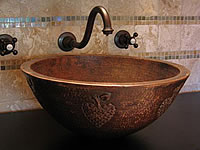Copper Considerations
By Lisa November 4th, 2010

Ever thought about having a copper sink? They are beautiful, timeless, and versatile in their styling. The use of copper predates historical records by millions of years! And did you know that copper is antimicrobial? If you’re considering a copper sink, keep the following in mind:
Look for a copper sink that is certified to be lead and mercury free, especially when they have been made in countries other than the US. Most readily available copper sinks come from Mexico, India, or South America; many are made of recycled materials, (perhaps questionable materials), and environmental controls are not the same from country to country. Also look for a gauge of 16 or even 14 if you can find it. Copper is fairly soft which makes that gauge really important.
Some copper sinks have a waxed or lacquered finish. This will inhibit the natural patina from developing. You may think that’s a good thing. However, that coating could wear off unevenly from use or cleaning, leaving you with a spotty patina which you did not intend!
Hammered copper is a popular look and easy to find. Note that if the indentations are deep, water can pool in them making it more difficult to clean. Some sinks are machine hammered, some are hand hammered. The sinks done by hand will have a more organic, artisanal look versus the evenness of the machine.
Many sinks are handmade and there will not be a template for your countertop manufacturer. This may be fine, but the sink may be slightly misshapen which could make it more difficult to install. Also, many do not have overflow drains. Not a big deal if you never fill up the sink or it doesn’t clog… if so, you’d better look for one with an overflow!
I don’t want you to shy away from using a copper sink if that will achieve the right look for your space. Just be aware of the considerations and do your homework.
